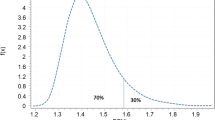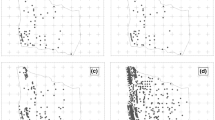Abstract
The present paper describes the algorithm and working method for detection and estimation of proximate parameters of coal beds based on digital well-log data. Designed and developed by the authors in Visual Studio using C#, ProxInLAS is used to define a threshold value on each log to distinguish between coal and non-coal layers, followed by estimating each of the coal proximate parameters by importing the data pertaining to a particular borehole: the reference borehole. Inputs of the software include the reference borehole data, target functions for accepting a layer as coal, and the methods employed to estimate the proximate parameter. The software relies mainly on two algorithms, a detection algorithm for detecting coal layers, and an estimation algorithm for estimating proximate parameters of the detected layers. Loaded by the well-log and core-sampling data, the detection algorithm calculates a set of threshold values to distinguish between the coal and non-coal layers based on the frequency distribution function of the well-log values near coal beds. ProxInLAS offers four methods for estimating proximate parameters: (1) a method based on the regression between the considered parameter and a particular log, (2) a method based on a combination of several linear relationships, (3) radial basis function (RBF) method, and (4) geostatistical interpolation method. In addition to numeric records, the software can present its outputs graphically to provide a simple and instant view of the results. The case study used to evaluate the performance of ProxInLAS.







Similar content being viewed by others
Availability and Requirements
The executive files of the software are available via the link below:
https://1drv.ms/u/s!ApSd-8MK33-ngWbujdO8HdMBvRZl
To run ProxInLAS, the zip file downloaded from the above link should be extracted and the executive file of “WindowsFormsApplication3.exe” would be executed directly. The software needs “.Net Framework 4.5” or above to be run correctly. ProxInLAS has been tested on the Operating System of Windows 10 and 7, and executing correctly in other versions of above Windows 7 is expected.
References
Borsaru M, Zhou B, Aizawa T, Karashima H, Hashimoto T (2006) Automated lithology prediction from PGNAA and other geophysical logs. Appl Radiat Isot 64:272–282
Das B, Chatterjee R (2017) Wellbore stability analysis and prediction of minimum mud weight for few wells in Krishna-Godavari Basin, India. Int J Rock Mech Min Sci 93:30–37
Das B, Chatterjee R (2018) Well log data analysis for lithology and fluid identification in Krishna-Godavari Basin, India. Arab J Geosci 11:231–242
England, S., & Brunton, J. (2004a). Preparation and analysis of Ridgelands stage 2 exploration slim Core - DM Ridgelands DDH 8. Retrieved from Warabrook NSW:
England, S., & Brunton, J. (2004b). Preparation and analysis of Ridgelands stage 2 exploration slim Core - DM Ridgelands DDH 13. Retrieved from Warabrook NSW:
Fallon G, Fullagar PK, Zhou B (2000) Towards grade estimation via automated interpretation of geophysical borehole logs. Explor Geophys 31:236–242
Fullagar PK, Zhou B, Fallon GN (1999) Automated interpretation of geophysical borehole logs for orebody delineation and grade estimation. Miner Resour Eng 8(3):269–284
Fullagar P, Zhou B, Biggs M (2003) Stratigraphically-consistent auto-interpretation of borehole data. J Appl Geophys 55:91–104
Ghosh S, Chatterjee R, Paul S, Shanker P (2014) Designing of plug-in for estimation of coal proximate parameters using statistical analysis and coal seam correlation. Fuel 134:63–73
Ghosh, S., Chatterjee, R., Shanker, P., & Paul, S. (2016). Estimation of ash, Moisture Content and Detection of Coal Lithofacies from Well logs using Regression and Artificial Neural Network Modelling. Paper presented at the Fuel
Gogoi T, Chatterjee R (2018) Estimation of petrophysical parameters using seismic inversion and neural network modeling in Upper Assam Basinn, India. Geosci Front. https://doi.org/10.1016/j.gsf.2018.07.002
Hofman GL, Jordan GR, Wallis GR (1982) Geophysical borehole logging handbook for coal exploration. The Coal Mining Research Centre, Alberta
JOURNEL, A. G., & HUIJBREGTS, J. (1978). Mining Geostatistics. London: Academic Press, New York , San Francisco
Kayal JR (1979) Electrical and gamma-ray logging in Gondwana and tertiary coalfields of India. Geol Explor 17:243–258
Kayal JR, Christoffel DA (1989) Coal quality from geophysical logs: Southland lignite region. Society of Petrophysicists and Well-Log Analysts, September–October, New Zealand, pp 343–352
Kiš IM (2016) Comparison of ordinary and universal kriging interpolation techniques on a depth variable (a case of linear spatial trend), case study of the Šandrovac field. The Mining-Geology-Petroleum Engineering Bulletin 31(2):41–58. https://doi.org/10.17794/rgn.2016.2.4
Kitzig MC, Kepic A, Kieu DT (2017) Testing cluster analysis on combined petrophysical and geochemical data for rock mass classification. Explor Geophys 48:344–352
Kriging - Wikipedia (2018) Retrieved from https://en.wikipedia.org/wiki/Kriging. Accessed 2018
Oyler DC, Mark C, Molinda GM (2010) In situ estimation of roof rock strength using sonic logging. Int J Coal Geol 83:484–490
Paz-Ferreirol J, VázquezI EV, Vieira SR (2010) Geostatistical analysis of a geochemical dataset. Bragantia 96:121–129
Robert, D., & Crangle, J. (2007). Log ASCII standard (LAS) files for geophysical wireline well logs and their application to geologic cross sections through the central Appalachian basin, open file report. Retrieved from Reston, Virginia
Roslin A, Esterle JS (2016) Electrofacies analysis for coal lithotype profiling based on high-resolution wireline log data. Comput Geosci 91:1–10
Srinaiah J, Raju D, Udayalaxmi G, Ramadass G (2018) Application of Well Logging Techniques for Identification of Coal Seams: A Case Study of Auranga Coalfield, Latehar District, Jharkhand State, India. J Geol Geophys 7(1):1–11
Thomas LP (2013) Coal geology. Wiley-Blackwell, Chichester, West Sussex
Webber T, Costa JFCL, Salvadoretti P (2012) Using borehole geophysical data as soft information in indicator kriging for coal quality estimation. Int J Coal Geol 122:67–75. https://doi.org/10.1016/j.coal.2012.11.005
Wellcome to DIGS - NSW Trade and Investment - DIGS (2015) Geological Survey of NWS, DIGS Database. Retrieved from http://digsopen.minerals.nsw.gov.au/. Accessed 2018
Yusefi A, Ramazi H (2019) COALINLAS, a software for detecting coal beds in well-logs. Earth Sci Inf 12(1):129–142. https://doi.org/10.1007/s12145-018-0357-3
Zhou B, Esterle J (2008) Toward improved coal density estimation from geophysical logs. Explor Geophys 39(2):124–132
Zhou B, O'Brien G (2016) Improving coal quality estimation through multiple geophysical log analysis. Int J Coal Geol 167:75–92
Zhou B, Guo H, Hatherly P, Poulsen B (2001) Automated geotechnical characterisation from geophysical logs: examples from southern colliery, Central Queensland. Explor Geophys 32:336–339
Zhou B, Fraser S, Borsaru M, Aizawa T, Sliwa R, Hashimoto T (2005) New approaches for rock strength estimation from geophysical logs. Yeppoon, Queensland
Author information
Authors and Affiliations
Corresponding author
Additional information
Publisher’s note
Springer Nature remains neutral with regard to jurisdictional claims in published maps and institutional affiliations.
Rights and permissions
About this article
Cite this article
Yusefi, A., Ramazi, H. ProxInLAS, a software program for detecting coal layers and estimating parameters of layers, using geophysical well-logs. Earth Sci Inform 12, 415–427 (2019). https://doi.org/10.1007/s12145-019-00382-3
Received:
Accepted:
Published:
Issue Date:
DOI: https://doi.org/10.1007/s12145-019-00382-3




